Water is a main event for many people, whether it be in a backyard pool, a mountain stream or a reservoir.
Children are particularly drawn to water. And that propensity gets worse when it runs deep and fast.
Here are some tips for maintaining a safe environment near water for children.
•Maintain constant supervision. Watch children around any water environment (pool, stream, lake, tub, toilet, bucket of water), no matter what skills a child has acquired and no matter how shallow the water.
•Don’t rely on substitutes. The use of flotation devices and inflatable toys cannot replace parental supervision. Such devices could suddenly shift position, lose air, or slip out from underneath, leaving the child in a dangerous situation.
•Enroll children in a water safety course or Learn to Swim program. The decision to provide a child with an early aquatic experience is a gift that will have infinite rewards. These courses encourage safe practices.
•Parents should take a CPR course. Knowing these skills can be important around the water and you will expand your capabilities in providing care for your child. You can contact your local Red Cross to enroll in a CPR for Infants and Child course.
•Learn to swim. The best thing anyone can do to stay safe in and around the water is to learn to swim–this includes adults and children. The American Red Cross has swimming courses for people of any age and swimming ability. To enroll in a course to learn or improve your ability to swim, contact the local Red Cross chapter.
•Never leave a child unobserved around water. An adults eyes must be on the child at all times.
•Install a phone by a pool/hot tub or keep a cordless phone nearby so that someone can call 9-1-1 in an emergency.
•Post CPR instructions and 9-1-1 or the local emergency number in the pool area.
•Enclose the pool completely with a self-locking, self-closing fence with vertical bars. Openings in the fence should be no more than four inches wide. A house should not be included as a part of the barrier.
•Never leave furniture near a fence that would enable a child to climb over the fence.
•Always keep basic lifesaving equipment by the pool and know how to use it. Pole, rope, and personal flotation devices (PFDs) are recommended.
•Keep toys away from the pool when it is not in use. Toys can attract young children into the pool.
•Pool covers should always be completely removed prior to pool use.
•If a child is missing, check the pool first. Go to the edge of the pool and scan the entire pool, bottom, and surface, as well as the surrounding pool area
Water is fun, but dangerous for children

